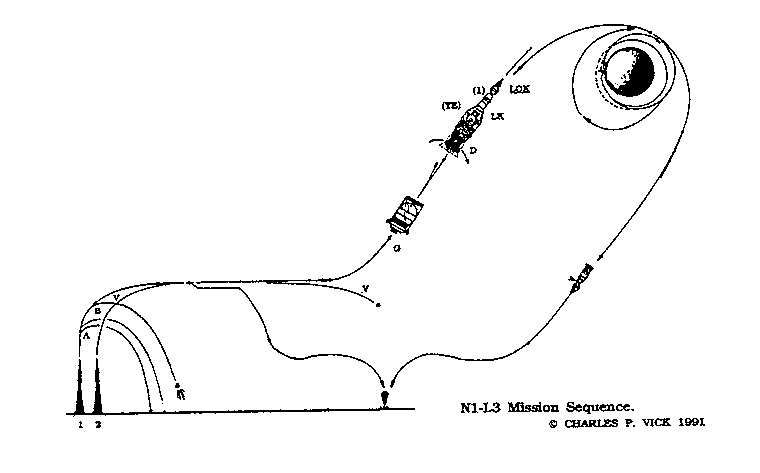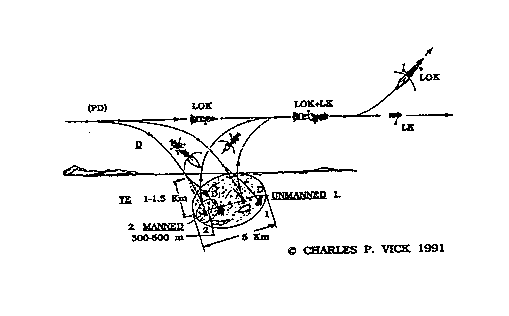



SPACEFLIGHT, Vol. 38, 1996
Korolev presented a directive to his chief designers in early 1965, well before his death in January 1966, which finalized the actual manned lunar landing mission sequence as well as the Nl-L3 design. How much of the mission profile was changed by the political and ministerial technocratic leadership is unclear except that L. Brezhnev, First Secretary of the CPSU, ordered that once an unmanned Nl-L3 had flown successfully, Mishin was to fly the next mission manned.
The Soviet manned lunar landing mission sequence, as developed by General Designer Acad S. P. Korolev, is not quite what has previous been presented publicly. A series of interviews conducted at the June l99l Paris Air Show with Vassili P. Mishin, the chief designer at the time of the Soviet lunar programme, revealed answers to several long-standing questions including that of the lunar mission profile.
The manned mission envisioned a minimum of two separate unmanned Proton/Luna launches that had to work and two N1-L3 launches. The first N1-L3 was to be unmanned and the second was to be manned. This was done for safety reasons in case the manned Lunar Cabin (LK), which the second one launched, failed to take off from the Lunar Surface.
Prior to this at least two unmanned Proton/Lunas were to be dispatched to serve as landing guidance beacons for the L-3 Lunar Cabins. As the Soviets considered the American lunar module to be a risky design and to have a risky mission format they felt that they had to provide a second rescue launch capability for their cosmonauts. The single cosmonaut could take an EVA lunar walk or Lunokhod ride to the second Lunar Cabin, which had landed before the manned lunar landing mission was committed to flight, to return to lunar orbit.
The mission configuration remained the same from early 1965 to the early 1970s. To quote cosmonaut A. Leonov, "It required and involved an incredible series of rendezvous". If any one of the early mission elements failed to be successfully performed it could have stopped the full mission attempt.

At that time, in 1965, the guidance designers felt that they could guarantee a second vehicle's ability to carry out a ballistic landing within five kilometres of the first vehicle. By 1969 this had been reduced down to less than 2.5 kilometres. The unmanned and manned Lunar Cabins were to land inside a five km target ellipse as the primary landing zone on fairly flat terrain.
This defined EVA requirements beyond the planned six hours of EVA (in lunar orbit and on the lunar surface) as two hours in lunar orbit and four hours for lunar surface operations with a one and a half hour contingency built into the timeline. This matches the seven and a half hour capacity of the present Orlan EVA spacesuit, used on Mir, with its smaller lighter backpack. The total design duration capability of the 105 kg Kretchet lunar mission EVA spacesuit for a generic 75 kg cosmonaut allowed for a minimum of 10 hours to in excess of 12 hours maximum operation depending on the rate of use. This was due to the larger capacity life support oxygen bottle and the larger lithium hydroxide absorber canister within the EVA backpack. It was physically larger than the present carbon dioxide absorber canister and the present oxygen bottle. Work on the Kretchet lunar suit was started in 1965. Its design changes reflected the considerable experience gained from the Voskhod EVA suit.
Under normal operating conditions the lunar surface EVA was to be limited to four hours and an area of only 300-500 m from the Lunar Cabin. Lunar cosmonaut's training further stipulated requirements to demonstrate a capability to carry out a Moon walk of up to five km distance, whether an Original design Lunokhod was available or not. This very tough training requirement included navigating the way back to the unmanned Lunar Cabin. A mini-rover was also to be deployed from the Lunar Cabin while on the lunar surface.
The powered descent from a 110 km to a 16 km orbit utilised a very steep constant burn Block-D operation requiring less total descent deceleration than the American powered descent operation. The cosmonaut would have sight of the landing spot and the first unmanned Lunar Cabin already on the lunar surface very early on during this powered descent. However, the Block-D lunar braking module provided very little manoeuvering capability by its gimbal mounted engine and stationary thruster. The final powered descent to the lunar surface with full manoeuvering capability was carried out by the Block-Ye of the LK Lunar Cabin in unmanned automatic control mode or under the cosmonaut's control after separation from the Block-D between 2.0-1.5 and 0.5 km altitude. This landing regime provided about twenty five seconds for the final landing. All Soviet manned lunar landings were to be restricted to fairly flat surface conditions and precluded mountainous landings. An account of the N1-L3 launch and lunar landing scenario has previously been given by Bart Hendrickx [1].

N1-L3 and Proton/Luna countdowns utilised the same launch windows that lasted under a week. Often both the 1M1 test vehicle (for testing the N1-L3 ground facility systems) and the N1-L3 actual flight test vehicle, of which there were always two, were tested in demonstration count downs. The purpose of the repeated use of the 1M1 ground test vehicles was to keep the facilities and the launch personnel trained and ready, since many of the drafted personnel were conscripts and were constantly being changed. It was important to avoid problems before anything was carried out with the flight test vehicle. The build up to launch of N1-L3 took twenty-eight days while the final count down took only two days. Whether the mission was to be stretched over two months, which is most probable, or just have several days between launches is unclear as both were in principle possible as long as the vehicles were preprepared. In effect the Soviet manned lunar landing mission profile not merely used Lunar Orbital Rendezvous (LOR), but also used Lunar Surface Rendezvous (LSR), with multiple independent launches of at least two unmanned Proton/Lunas and an unmanned and a later manned N1-L3/SL-X-15.
This is Part 3 of The Mishin Mission by Charles P. Vick. For Part 1 see JBIS, 47, 9, September 1994, p.357 and for Part 2 see Spaceflight January 1996, p.28.